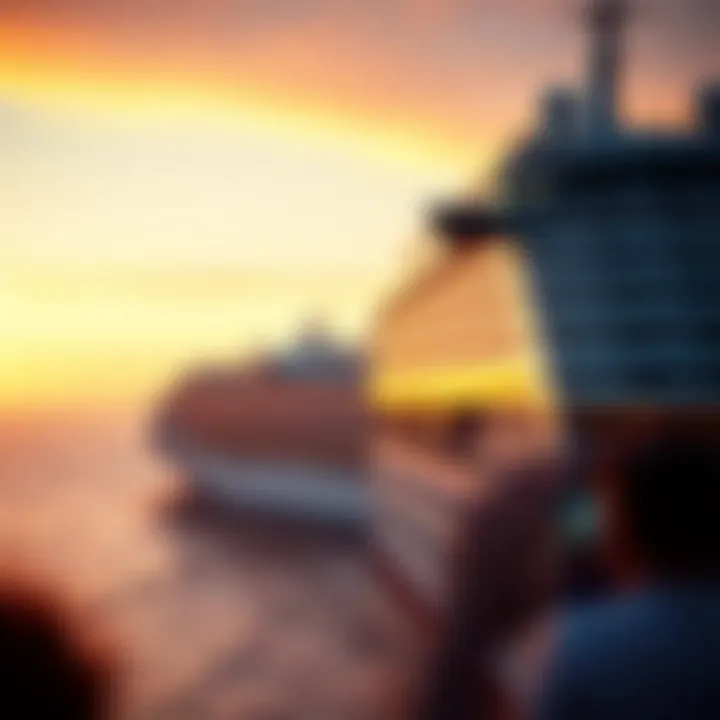MGM and Royal Caribbean: Shaping Gaming and Leisure


Intro
In today's fast-paced world of leisure and entertainment, the marriage between gaming and cruising stands out as an innovative frontier. Combining the lavish experience of casinos with the luxury of cruise liners offers an appealing choice for those seeking excitement and relaxation in one package. MGM Resorts International and Royal Caribbean International represent two giants in their respective arenas. Their partnership provides a glimpse into the future of integrated entertainment, showcasing how these entities influence the evolving landscape of leisure.
By merging MGM's expertise in creating thrilling casino experiences with Royal Caribbean’s prowess in providing unforgettable cruises, a new realm of possibilities opens up for entertainment enthusiasts. Understanding their strategies is crucial—not only for industry insiders but also for players and travelers who want to enjoy the best of both worlds.
Prologue to MGM and Royal Caribbean
In today’s world of entertainment and leisure, two names often stir excitement: MGM Resorts International and Royal Caribbean International. These industry giants don’t merely stand as individual entities; they embody a significant confluence of gaming and cruising. This intersection represents more than just business initiatives; it’s a transformative approach toward reimagining how people experience leisure in an interconnected, evolving marketplace.
The collaboration between these two powerhouses highlights their innovative strategies that cater to a diverse audience—from the adventurous traveler seeking thrilling nautical escapades to the seasoned gambler eyeing the bright lights of a lavish casino. By understanding the unique contributions of each, we can begin to see how they enhance one another’s offerings, creating a holistic environment that caters to a variety of interests.
Overview of MGM Resorts International
MGM Resorts International, headquartered in Las Vegas, Nevada, has made a name for itself as a leader in the hospitality and gaming industry. Operating a collection of world-renowned hotels and casinos—like the Bellagio and Mandalay Bay—it blends luxury accommodations with a dazzling array of entertainment options. With a commitment to providing unparalleled guest experiences, MGM has continuously evolved its offerings to include fine dining, top-tier nightlife, and spectacular shows that draw millions of visitors annually.
MGM is also a pioneer in adopting cutting-edge technology in gaming. For instance, the introduction of mobile betting applications and advanced loyalty programs sets it apart from competitors. MGM has managed to engage a wide demographic by expanding its entertainment scope, providing not merely slots and table games but also live entertainment and culinary adventures.
Overview of Royal Caribbean International
Royal Caribbean International, on the other hand, has carved out a niche in the cruise industry by pushing the boundaries of what a cruise experience should be. Established in 1968, this cruise line is recognized for its innovative ships equipped with features like surf simulators, ice skating rinks, and even the world’s tallest slide at sea. Each voyage promises not just transportation but a journey full of activities and adventures suited for travelers of all ages.
With a focus on enhancing customer experience, Royal Caribbean continually invests in new technologies and sustainable practices. They also offer unique themed cruises and immersive experiences aimed to appeal to specific interests, such as wellness, music festivals, and culinary explorations. Their commitment to providing guests with unforgettable experiences mirrors MGM’s dedication to entertainment and luxury.
In summary, the intersection of MGM and Royal Caribbean signifies more than just business collaboration; it reflects a comprehensive approach in the gaming and entertainment sectors, presenting opportunities for enhanced guest experiences. As we delve deeper into the historical context, business strategies, and mutual impacts of these two entities, we will cultivate a clearer picture of their collective influence on the gaming and cruising landscapes.
Historical Context of MGM and Royal Caribbean
Understanding the historical context of MGM Resorts International and Royal Caribbean International sheds light on their current strategies and aspirations. This background is crucial as it helps to put into perspective their developments in not just gaming and cruising but also in how they intersect. Both entities have shaped the leisure landscape, informing trends that connect gaming experiences with travel and vacationing. Examining their past allows us to grasp how they evolved in response to industry shifts, consumer preferences, and technological advancements.
MGM's Evolution in the Casino Industry
MGM Resorts, a titan in the hospitality and gaming sector, has undergone a significant transformation since its inception. Founded as a small film studio, MGM transitioned into a powerhouse of the casino industry following the establishment of its Las Vegas properties. One can trace a line from the opulent Bellagio, with its flowing fountains and sophisticated atmosphere, to the high-energy vibe of the MGM Grand.
The company's adaptation to changing market demands is notable. For instance, in the 1990s, while the demand for traditional gaming remained strong, MGM recognized the rising interest in broader entertainment offerings. They began incorporating diverse attractions such as world-class dining and intricate shows, inviting not only gamblers but also families and tourists seeking rich experiences.
MGM's approach to technology has also played a pivotal role in its evolution. With the advent of online gaming, MGM has pushed boundaries, launching platforms that merge the thrill of traditional casino experiences with the convenience of online access. Their ability to stay ahead of the curve, especially amid regulatory changes, speaks volumes of their resilience and strategic foresight.
Royal Caribbean's Growth in the Cruise Sector
Meanwhile, Royal Caribbean’s rise in the cruise sector is a saga intertwined with innovation and customer-centric upgrades. Starting with modest ships that catered to a specific segment of travelers, Royal Caribbean embarked on a journey to redefine cruising. In the 1980s, the company's introduction of the Sovereign of the Seas marked a breakthrough in the industry, boasting features that were unprecedented at the time, such as a multi-deck atrium and expansive recreational areas.
As time went on, Royal Caribbean embraced an ethos of constant improvement. They began to offer unique onboard experiences like rock climbing walls and surf simulators, clearly demonstrating their aim to position cruising as a vibrant alternative to traditional vacationing. This pivot reflected a broader change in consumer preferences toward experiential travel, where the journey is as compelling as the destination.
The company’s agility is further evident in their adaptation to sustainable practices, embracing green technologies to address environmental concerns, appealing to a more conscientious traveler in today’s eco-aware climate.
The histories of MGM and Royal Caribbean, while distinct, share a mutual theme of innovation and adaptation, which serves as a testament to their industry leadership.
The evolution of both MGM and Royal Caribbean illustrates not only their rise to prominence but also sets the stage for their future endeavors in a rapidly evolving market. By examining their historical paths, one can appreciate the interconnectedness of gaming and cruising as both industries continue to innovate and reimagine leisure for a new generation.
Business Strategies of MGM
The business strategies employed by MGM Resorts International are pivotal not just for their own growth, but they also set a benchmark in the gaming and entertainment industry. As the landscape of gaming continues to evolve, MGM’s approach showcases a blend of innovation, customer-centricity, and diversification. Understanding these strategies allows for a detailed exploration of how MGM adapts to changing market dynamics while enhancing their offerings for gamers and entertainment seekers alike.
Diversification of Entertainment Offerings
MGM's diversity in entertainment is akin to a buffet where guests can sample various dishes, ensuring satisfaction for every palate. The goal goes beyond merely offering gaming options; MGM curates a full-scale experience that encompasses dining, shows, and nightlife. This holistic approach helps MGM to stand out in a crowded market.
- Entertainment Venues: Features like the Park MGM and its state-of-the-art concert arenas or lavish theaters attract a wide range of visitors—from families to concert-goers. They focus on live performances, which not only brings in revenue but also builds a community around the brand.
- Dining Experiences: The emphasis on culinary options, ranging from Michelin-starred establishments to casual eateries, caters to diverse tastes and preferences. This strategy not only generates foot traffic but also creates a mentioned synergy with the gaming facilities.
- Integrative Experiences: By leveraging partnerships with renowned chefs and entertainers, MGM creates exclusive events, encouraging guests to stay longer and engage more deeply with both the games and the overall atmosphere.


Innovative Gaming Solutions
In the realm of gaming, MGM is not one to rest on its laurels. It continually seeks to reinvent the player experience through technology and creativity.
- Technology Enhancements: Utilizing cutting-edge technology like cashless gaming and mobile apps, MGM enhances the gambling experience by promoting convenience and security. This innovation helps improve the overall satisfaction of guests. Moreover, offering loyalty bonuses through an app ensures that regular players feel appreciated and valued.
- Interactive Gameplay: Implementing skill-based gaming has been a game changer, literally. These offerings appeal to younger audiences who might be more inclined to engage in competitive play rather than traditional slot machines. By redesigning how games are played, MGM taps into new demographics eager for interactive experiences.
"As the market evolves, the need for companies to embrace tech innovations in their gaming offerings is more urgent than ever. MGM is setting trends, not just following them."
- Focus on Data and Analytics: MGM employs advanced analytics to study player behavior, preferences, and trends, allowing them to tailor their gaming options more effectively. Insights gleaned from data help MGM tweak offerings in real-time, improving customer retention by ensuring that their needs are met.
Through these strategies, MGM not only fortifies its market position but also enriches the overall gaming and entertainment landscape. By ensuring a variety of entertainment experiences and focusing on innovation, MGM solidifies its role as a leader in a complex and competitive industry.
Business Strategies of Royal Caribbean
The competitive landscape in the cruise industry is constantly shifting, and Royal Caribbean has found a way to stand out among its peers through a series of well-thought-out business strategies. These strategies play a crucial role in engaging customers and enhancing their experiences while also addressing broader concerns, such as sustainability. Understanding these approaches not only sheds light on Royal Caribbean’s market position but also highlights its potential to redefine cruise experiences in collaboration with entities like MGM Resorts.
Enhancing Onboard Experiences
The core of Royal Caribbean’s strategy revolves around creating unforgettable onboard experiences. They have revolutionized the cruise experience by introducing state-of-the-art amenities. Each ship is designed like a floating city, with an array of features that cater to diverse interests.
- Innovative Attractions: Royal Caribbean has integrated various cutting-edge attractions, such as flow riders and rock climbing walls, which bring an amusement park vibe to the experience. And yes, they haven’t skimped on luxury either; guests can savor specialty dining at places like Wonderland or Chops Grille while enjoying fine cuisine.
- Entertainment Choices: The line’s partnership with top-tier entertainment providers allows them to stage Broadway-style shows and live concerts, turning at-sea nights into memorable events. Through a carefully curated entertainment schedule, cruisers can enjoy everything from high-energy performances to intimate jazz sessions.
- Culinary Diversity: The culinary offerings on a Royal Caribbean cruise are nothing short of spectacular. Passengers are treated to an array of dining options, reflecting various cuisines from around the globe. Each meal feels like a culinary journey, making dinner an experience in itself.
This dedication to enhancing onboard experiences allows Royal Caribbean to keep guests engaged and entertained, thus ensuring a memorable cruise that often leads to repeat business.
Sustainability Initiatives
In an era where environmental consciousness has become paramount, Royal Caribbean is stepping up its game with sustainability initiatives that are as commendable as they are innovative. This commitment not only aids the environment but also resonates deeply with today’s eco-aware travelers.
- Reduced Carbon Footprint: The cruise line has invested heavily in new technology aimed at reducing emissions. This includes advanced waste management systems and cutting-edge propulsion systems that significantly lessen their environmental impact.
- Sustainable Sourcing: Royal Caribbean is also focused on sourcing food and materials sustainably. Their farm-to-ship program ensures that the ingredients used in their kitchens support local economies and promote sustainable farming practices.
- Community Engagement: By engaging with local communities and supporting conservation efforts in the areas they visit, Royal Caribbean helps protect the ecosystems that make their routes so appealing to travelers. Their partnerships with organizations for marine conservation are paving the way for more responsible tourism practices.
Royal Caribbean is not just about cruising; it is about redefining how leisure travel coexists with sustainability and social responsibility.
Through these sustainability initiatives, the cruise line is reaffirming its commitment to being a responsible corporate citizen while reaping the benefits of attracting travelers who prioritize environmental stewardship.
In summary, Royal Caribbean's business strategies encapsulate a commitment to creating memorable onboard experiences through entertainment and culinary offerings, coupled with a strong focus on sustainability. The intersection of these elements is shaping the future of cruising in a manner that aligns seamlessly with ongoing trends in travel and leisure.
Collaboration and Synergies
The collaboration between MGM Resorts International and Royal Caribbean International serves as a dynamic portrait of how two distinct but intertwined industries can thrive together. Both entities, while representing different sectors of entertainment, realize that combined efforts yield significant advantages. This intersection leads to enhanced consumer experiences, expansion of services, and impressive revenue growth. In an era where customer expectations are always on the rise, collaboration becomes more than just a strategy; it’s a necessity.
Strategic Partnerships
Strategic partnerships between MGM and Royal Caribbean exemplify the power of pooling resources and expertise. By aligning their brand identities and leveraging their mutual strengths, both companies create a robust ecosystem that lures a more diverse clientele. For instance, when Royal Caribbean announces new cruises featuring an exclusive MGM nightlife experience on board, it not only attracts avid gamblers but also those interested in premium entertainment. This cross-promotional strategy allows both companies to tap into each other’s audience bases effectively.
Further, these partnerships can lead to innovative products and services, such as tailored gaming experiences onboard Royal Caribbean ships that reflect MGM's renowned gaming environments. Think, for example: a high-stakes poker night hosted by MGM experts right in the cruise ship's casino. Such initiatives foster brand loyalty and keep customers engaged even when they transition from land to sea.
Overall, collaborative efforts foster creativity. When MGM and Royal Caribbean share ideas, the gaming experiences offered onboard evolve significantly. This partnership doesn’t just build excitement; it also helps galvanize the gaming and entertainment industries as a whole.
Impact on Consumer Engagement
The convergence of MGM and Royal Caribbean is more than just business synergy; it’s a transformation in how consumers engage with both gaming and cruising. When customers think about a vacation, they no longer just picture the beautiful landscapes; they envision entertainment as a multi-dimensional experience. Such engagement is amplified when they can anticipate lucrative perks and distinct experiences offered through well-integrated loyalty programs and joint promotions.
For example, discounts on cruise bookings for MGM rewards members encourage loyalty among existing customers while inviting newcomers to explore what both brands offer. This not only enhances consumer engagement but also improves the likelihood of return visits, whether to a casino or a cruise.
Another aspect worth noting is the social media engagement stimulated by their collaborations. When Royal Caribbean launches a new cruise featuring an MGM theme, social media campaigns engage users by inviting them to share their experiences. These connections foster a community where loyal customers feel valued and part of something bigger than just a brand.
Casino Experiences on Royal Caribbean Ships
The fusion of gaming and cruising on Royal Caribbean ships presents a novel realm of enjoyment for travelers who relish thrill and entertainment. The onboard casinos serve not only as a venue for gambling but also as a social hub, offering a unique charm that amplifies the overall cruising experience. This section will explore how these casino experiences are designed and the extensive range of games available, revealing their significance in attracting gambling enthusiasts and casual players alike.
Design and Atmosphere


Layout and Theme
The layout and theme of Royal Caribbean's casinos play a crucial role in defining the experience for guests. Unlike traditional brick-and-mortar casinos, the designs aboard cruise ships often incorporate maritime aesthetics fused with contemporary luxury. Spacious and illuminated, the layout is intended to create a vibrant atmosphere that keeps guests engaged. The key characteristic is the open design that allows natural light to filter in, a departure from the often windowless environments found in land-based casinos.
A unique feature of this design is the integration of an oceanic theme, which resonates with the overall cruise experience, pleasing both avid gamblers and vacationers who may just be passing through. This thematic consistency ensures that the casino becomes not just a place to gamble but a part of the broader holiday experience. On the downside, some may argue that the limited size of onboard casinos can restrict game variety, especially when compared to larger counterparts in Las Vegas or Atlantic City.
Integration with Entertainment
Casino experiences on Royal Caribbean ships are notably enhanced by their seamless integration with entertainment options available throughout the vessel. The essential characteristic of this integration is its ability to provide entertainment beyond the gaming tables, merging live shows, themed nights, and special events with casino activities. This is beneficial because it attracts a diverse group of travelers, some of whom might not typically visit a casino but are drawn in by the surrounding activities.
A unique aspect of this combination is the opportunity for themed casino nights, where guests can enjoy their favorite games while engaging in fun dress codes or live music. This not only enhances the casino's appeal but encourages social interaction, fostering a lively atmosphere. However, a potential disadvantage is the distraction that entertainment can sometimes cause for serious gamblers who prefer a quieter, focused setting while trying their luck at tables.
Gaming Options Available
Royal Caribbean ships pride themselves on offering a variety of gaming options that cater to different preferences among passengers. The spectrum of games available ensures that both casual gamers and serious bettors have something to enjoy while sailing the seas.
Table Games
Table games represent a core component of the gaming experience onboard Royal Caribbean vessels. The classic offerings, such as blackjack, poker, and roulette, hold a prominent place. The distinctive atmosphere surrounding these games is both inviting and competitive, with dealers often well-trained to engage players effectively.
The advantage of having multiple versions of popular games allows guests to choose their preferred stake levels and styles. For example, low-stakes tables cater to beginners or those looking to have a bit of fun without breaking the bank. However, one consideration is that the limited number of tables may lead to longer wait times during peak hours, particularly on bustling cruises.
Slot Machines
Slot machines are perhaps the most popular gaming option available on Royal Caribbean ships. Their easy-to-play format attracts a broad audience, making them accessible for novices and seasoned players alike. One of the key characteristics of these machines is their diverse range of themes and payout structures, encompassing both classic designs and modern video slots.
What sets these slots apart on a cruise ship is their constant connection to various promotions and jackpot events, which can create an enticing environment for players hoping to take home a larger prize. The drawback, though, lies in the fact that the payout percentages for cruise ship slots can differ from land-based casinos, which may lead some experienced gamblers to seek more favorable odds off the ship.
With the right balance of design, integration with entertainment, and a broad range of gaming options, Royal Caribbean successfully creates an attractive and vibrant casino experience that accommodates the varied preferences of its passengers. As both MGM and Royal Caribbean continue to innovate and collaborate, the evolution of these offerings is likely to further enhance the landscape of gaming at sea.
Customer Loyalty Programs
In the bustling spheres of gaming and cruising, customer loyalty programs serve as critical pillars supporting both MGM Resorts International and Royal Caribbean International. They act as the lifeblood of these enterprises, laying down paths for customers to engage more deeply with the brands they prefer. These loyalty initiatives don’t just foster repeat business; they cultivate a community of avid patrons who feel a sense of belonging and appreciation.
The key elements of these programs revolve around rewards, recognition, and tailored experiences. When customers participate in loyalty schemes, they have the opportunity to earn points that can be redeemed for various services, be it an extra night at a hotel, complimentary meals, or credits for gaming. This translates into real value for the customer, who continually seeks to maximize their experience. Moreover, the success of a loyalty program can hinge on how well a company understands its audience, adapting the rewards to meet their needs and preferences.
Benefits are multifaceted. For the customers, these programs not only enhance their overall experience but also encourage further engagement through offers tailored to their habits and interests. For the businesses, loyalty translates into higher retention rates, increased expenditure per customer, and richer customer data that can be used to refine marketing strategies. In the context of MGM and Royal Caribbean, weaving such customer-centric programs into their operational fabric allows for a more cohesive experience, bridging entertainment on land and at sea.
However, there are considerations to keep in mind. Developing and maintaining an effective loyalty program requires careful planning and execution. Businesses must be vigilant about keeping their offers fresh and enticing while protecting customers' data privacy. If mismanaged, a loyalty program has the potential to backfire, leading to disengagement rather than loyalty. As MGM and Royal Caribbean navigate this landscape, they need to continuously assess and innovate to keep their offerings appealing.
"Loyalty programs must evolve, or they risk becoming just another forgotten card in the wallet."
MGM Rewards Structure
MGM Rewards offers a robust framework designed to reward guests for their loyalty across various MGM properties. Members earn points for every dollar spent on eligible purchases—be it in gaming, dining, or entertainment. The structure is tiered, allowing members to climb levels, unlocking more benefits as they go. This hierarchy adds an element of prestige and urgency for members to pursue additional benefits, such as including exclusive access to events, room upgrades, and priority booking.
For example, a frequent visitor to MGM Grand might find themselves quickly accumulating points that lead to complimentary stays or experiences they might otherwise not indulge in. The tiered system encourages newer patrons to engage more earnestly, knowing that every bet or meal can elevate their status and consequently their rewards.
Royal Caribbean's Loyalty Program
The Royal Caribbean's loyalty program is branded as Crown & Anchor Society, which aims to create a strong bond between the cruiser and the line. Similar to MGM's rewards, members earn points based on the number of nights spent on their ships. As members sail more often, they move up tiers—Gold, Platinum, Emerald, Diamond, and Diamond Plus—each level bringing with it richer benefits. These can range from complimentary drinks to exclusive access to private events during sailing.
One distinct feature is how Royal Caribbean couples its loyalty rewards with personalized experiences onboard. For example, a Diamond Plus member may enjoy special dining options, or personalized service, that can enhance their cruising experience even further. The importance of tailoring specifically to returning guests cannot be understated. It strengthens customer connections and promotes longevity in patronage.
In summary, both MGM's and Royal Caribbean's customer loyalty programs are essential components of their overall business strategies, designed to nurture lasting relationships with their guests while simultaneously driving repeat business. With their unique structures, they reflect how deeply both enterprises value customer engagement and satisfaction. Through thoughtful rewards and an emphasis on increasing customer experience, these programs align with wider strategies to dominate in gaming and entertainment.
Cultural Impact of Gaming and Cruising
The blending of gaming and cruising creates a rich tapestry of entertainment and social interaction that is felt across various cultures and demographics. This intersection is not only about leisure but also about how people perceive and engage with both casinos and cruise experiences. The importance of this topic lies in understanding how these industries shape societal views and contribute to broader economic implications. As people flock to these entertainment hubs, they bring along diverse perspectives that enhance collective experiences.


Perception of Casinos in Society
Casinos, traditionally seen as places of high stakes and luck, have evolved in the public imagination. Gone are the days when they were merely associated with vice. Nowadays, establishments like those operated by MGM are often highlighted as family-friendly destinations. People visit not just for gaming, but also for lavish experiences, high-end dining, and world-class entertainment.
However, mixed views still exist. While many celebrate casinos as essential components of the entertainment fabric, some segments of society continue to view them dimly, often linking gambling with addiction and social decline. This duality can be seen in urban landscapes across the globe. Cities like Las Vegas project a vibrant atmosphere, inviting visitors to indulge, while local communities may struggle with the societal impacts of gambling.
Visiting a casino on a cruise ship, such as those offered by Royal Caribbean, can contribute further to the normalization of gambling. Passengers may initially board with the intent to relax, but find themselves drawn into games of chance amidst a lively atmosphere. Thus, the perception shifts from gambling as an isolated activity to an integral aspect of the broader vacation experience.
Tourism and Economic Effects
The symbiosis between gaming and cruising stimulates not just the economy of the companies involved but also those of the wider communities around them. As tourism swells around these hybrid experiences, cities often witness a surge in visitor spending. Here are a few vital points to consider:
- Job Creation: The growth of casinos on cruise ships necessitates a workforce ranging from dealers to entertainment staff. This influx creates jobs both on board and at land facilities.
- Local Economies: When cruise ships dock at ports, they often lead passengers to local businesses. A spike in tourism can benefit restaurants, shops, and attractions, contributing to overall economic health in these regions.
- Event Hosting: Both MGM and Royal Caribbean play host to tournaments and competitions, drawing in participants and spectators alike. Such events can make places staples for tourism and can even revitalize areas that might otherwise be overlooked.
Future Trends in Gaming and Cruising
The landscape of gaming and cruising is not static; it is shaped by evolving consumer desires and emerging technologies. Understanding these future trends is crucial for industry leaders like MGM Resorts International and Royal Caribbean International as they strive to stay ahead of the curve. Insights into upcoming trends can lead to better experiences for customers and innovative operational strategies for companies. As these two giants of leisure intersect, their ability to adapt to these changes will significantly impact their market positioning and consumer engagement.
Technological Innovations
Technological advancements continue to play a transformative role in both the gaming and cruising sectors. One such innovation is the rise of mobile gaming applications, which allow players to engage in casino-style games directly from their smartphones. This trend is not just limited to traditional gambling but also includes social gaming elements that encourage interaction and community building among players.
Moreover, MGM and Royal Caribbean are likely to harness technologies like virtual reality (VR) and augmented reality (AR) to create immersive gaming experiences. Imagine stepping into a virtual casino realm onboard a ship or entering a themed casino at a destination resort, where the lines between reality and fantasy blur. This could redefine the way patrons engage with their environment.
In addition, the adoption of blockchain technology for transactions can enhance security and transparency, making it an appealing option for gamers concerned about data privacy. Using cryptocurrencies would further streamline transactions, allowing for faster betting without the setbacks of traditional banking.
"The intersection of gaming and cruising presents a unique opportunity to leverage technology for unparalleled guest experiences."
List of emerging technologies shaping future trends:
- Mobile gaming apps: Allowing gaming on the go.
- Virtual reality and augmented reality: For a fully immersive experience.
- Blockchain and cryptocurrencies: Offering secure, decentralized transactions.
- Data analytics: For personalized gaming experiences based on user behavior.
Changing Consumer Preferences
As society evolves, so do the preferences of consumers. Today's gamblers are not just looking for a game to play; they seek a holistic entertainment experience that includes social interactions and unique atmospheres. They are more inclined toward experiences that can be shared on social media, integrating leisure activities with personal branding.
Furthermore, environmental concerns have influenced consumer choices within the cruise industry. Travelers increasingly favor companies that demonstrate sustainable practices. Both MGM and Royal Caribbean must consider implementing eco-friendly measures in their operations to align with this growing preference. That could include energy-efficient ships, waste reduction initiatives, and local sourcing of food and resources during cruises.
The desire for personalized experiences cannot be understated either. Gamblers and cruisers are moving away from one-size-fits-all offerings. Instead, they seek experiences tailored to their specific interests. This could manifest through customized vacation packages or personalized gaming options that enhance engagement.
In sum, keeping an ear to the ground regarding consumer sentiments, expectations, and values is paramount. Adaptation to these trends will not only enhance the customer experience but will also solidify the brand loyalty essential for both MGM and Royal Caribbean's long-term success.
Key consumer preferences to consider:
- Demand for unique, shareable experiences.
- Importance of sustainability in cruise choices.
- Desire for personalized gaming and cruising experiences.
- **Social connections and community involvement in leisure activities.
The End: The Future of MGM and Royal Caribbean
As the gaming and cruising sectors continue to evolve, the future of MGM Resorts International and Royal Caribbean International hinges on their capacity to adapt and innovate. This section of the article underscores the importance of their collaborative endeavors, offering insights into potential benefits while also signaling critical considerations moving forward.
Potential for Further Collaboration
Both MGM and Royal Caribbean are uniquely positioned to leverage each other's strengths for mutual growth. The cross-pollination of ideas and resources could refine customer experiences beyond traditional boundaries. Imagine a scenario where performance artists from Las Vegas make a splash on Royal Caribbean's stages, or where gamblers can take advantage of loyalty rewards redeemable at both MGM properties and onboard cruise ships. This seamless integration could entice a wider audience, blending the thrill of gaming with the relaxation of cruising.
Notably, their collaboration could present opportunities in niche markets. For example, themed cruises highlighting casino gaming could be developed, targeting dedicated gamblers. Similarly, joint marketing campaigns could draw attention to the synergy, where vacation packages include both gaming experiences and luxurious cruises. The key may lie in co-developing exclusive experiences that combine entertainment and leisure, making it a win-win situation.
However, this potential isn't merely about merging attractions; it’s about reimagining the entirety of leisure. Augmented reality gaming could be explored, allowing cruise-goers to engage with casino games while immersed in the ocean’s depth. Besides, as technology becomes more intertwined with entertainment, both entities may benefit from innovative platforms that enhance customer interaction, akin to mobile apps that consolidate gaming and vacation planning.
Navigating Challenges Ahead
Despite the promising potential, several challenges loom on the horizon. The gaming and cruise industries are not without their hurdles. Regulatory frameworks can differ significantly from one region to another. Managing these legal landscapes will be crucial, particularly as they seek to expand their collaborative initiatives. For instance, incorporating gambling on cruises often leads to complex legal challenges, especially concerning age restrictions and tax implications.
Economic fluctuations also pose a risk; consumer spending habits during downturns can directly impact both sectors. Should the economy falter, both MGM and Royal Caribbean may have to reassess their strategies dramatically. Building resilience through diversified offerings and flexible pricing structures could mitigate this vulnerability.
Additionally, they would need to maintain reputations for safety and customer service. As concerns about health, especially in a post-pandemic world, influence travel decisions, both companies can’t afford to rest on their laurels. They must assure customers that their entertainment options are as safe as they are appealing.
The future of MGM Resorts and Royal Caribbean is one that promises excitement and complexity, with collaboration at its core. An astute approach will not only embrace opportunity but also prepare for potential pitfalls, ensuring that the journey ahead is as rewarding as the destinations they offer.







